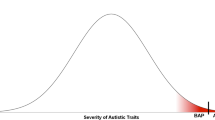Abstract
Examined thought disorder in a sample (n = 11) of high- functioning autistic young adults and older adolescents (mean IQ = 83) utilizing objective ratings from the Thought, Language and Communication Disorder Scale (TLC Scale) and projective data from the Rorschach inkblots. Results from the TLC Scale pointed to negative features of thought disorder in this sample (e.g., Poverty of Speech). Rorschach protocols revealed poor reality testing and perceptual distortions in every autistic subject, and also identified several areas of cognitive slippage (e.g., Incongruous Combinations, Fabulized Combinations, Deviant Responses, Inappropriate Logic). Comparing TLC Scale and Rorschach results to schizophrenic reference groups, autistic subjects demonstrated significantly more Poverty of Speech and less Illogically on the TLC Scale, and on the Rorschach they evidenced features of thought disorder that are encountered also in schizophrenia. Results are discussed in relation to the measures employed, and to areas of similarity and difference between autism and schizophrenia.
Similar content being viewed by others
References
American Psychiatric Association. (1980).Diagnostic and statistical manual of mental disorders (3rd ed.). Washington, DC: Author.
American Psychiatric Association. (1987).Diagnostic and statistical manual of mental disorders (3rd ed., rev.). Washington, DC: Author.
Andreasen, N. (1979a). Thought, language and communication disorders. I: Clinical assessment, definition of terms, and evaluation of their reliability.Archives of General Psychiatry, 36, 1315–1321.
Andreasen, N. (1979b). Thought, language and communication disorders. II. Diagnostic significance.Archives of General Psychiatry, 36, 1325–1330.
Cicchetti, D. (1984). On a model for assessing the severity of infantile attachment: Issues of observer reliability and validity.Behavioral and Brain Sciences, 7, 149–151.
Cochran, W., & Cox, G. (1957).Experimental designs. New York: Wiley.
DeMeyer, M., Hingtgen, J., & Jackson, R. (1981). Infantile autism reviewed: A decade of researchSchizophrenia Bulletin, 7, 388–451.
Exner, J. (1978).The Rorschach: A comprehensive system, Vol. 2: Current research and advanced interpretation. New York: Wiley Interscience.
Exner, J. (1985).A Rorschach workbook for the comprehensive system (2nd ed.). Bayville, NY: Rorschach Workshops.
Exner, J. (1986).The Rorschach: A comprehensive system, Vol. I: Basic foundations (2nd ed.). New York: Wiley Interscience.
Frith, U., & Baron-Cohen, S. (1987). Perception in autistic children. In D. Cohen, A. Donnellan, & R. Paul (Eds.),Handbook of autism and pervasive developmental disorders. New York: Wiley Interscience.
Green, W., Campbell, M., Hardesty, A., Grega, D., Padron-Gayol, M., Shell, J., & Erlenmeyer-Kimling, L. (1984). A comparison of schizophrenic and autistic children.Journal of the American Academy of Child Psychiatry, 23, 399–409.
Kolvin, I. (1971). Studies in childhood psychosis. I. Diagnostic criteria and classification.British Journal of Psychiatry, 118, 381–384.
Oltmanns, T., Murphy, R., Berenbaum, H., & Dunlup, S. (1985). Rating verbal communication impairment in schizophrenia and affective disorders.Schizophrenia Bulletin, 11, 292–299.
Paul, R. (1987). Communication. In D. Cohen, A. Donnellan, & R. Paul (Eds.),Handbook of autism and pervasive developmental disorders. New York: Wiley Interscience.
Paul, R., & Feldman, C. (1984).Communication deficits in autism. Paper presented at the Institute of Communication Deficits in Autistic Youth. New York: Columbia University.
Petty, L., Ornitz, E., Michelman, J., & Zimmerman, E. (1984). Autistic children who become schizophrenic.Archives of General Psychiatry, 41, 129–135.
Rosenthal, R., & Rubin, D. (1984). Multiple contrasts and ordered Bonferonni procedures.Journal of Educational Psychology, 76, 1028–1034.
Rumsey, J., Rapoport, J., & Sceery, W. (1985). Autistic children as adults: Psychiatric, social and behavioral outcomes.Journal of the American Academy of Child Psychiatry, 24, 465–473.
Rumsey, J., Andreasen, N., & Rapoport, J. (1986). Thought, language, communication and affective flattening in autistic adults.Archives in General Psychiatry, 43, 771–777.
Sigman, M., Ungerer, J., Mundy, P., & Sherman, T. (1987). Cognition in autistic children. In D. Cohen, A. Donnellan, & R. Paul (Eds.),Handbook of autism and developmental disorders. New York: Wiley Interscience.
Terman, L., & Merrill, A. (1972).Stanford-Binet Intelligence Scale. Boston, MA: Houghton Mifflin.
Volkmar, F., & Cohen, D. (1985). The experience of infantile autism: A first person account by Tony W.Journal of Autism and Developmental Disorders, 15, 47–54.
Volkmar, F., & Cohen, D. (1988). Diagnostics of pervasive developmental disorders. In B. Lahey & A. Kazdin (Eds.),Advances in clinical child psychology (Vol. 2). New York: Plenum Press.
Volkmar, F., Cohen, D., & Paul, R. (1986). An evaluation of DSM-III criteria for infantile autism.Journal of the American Academy of Child Psychiatry, 25, 190–197.
Watt, N., & Lubensky, A. (1976). Childhood roots of schizophrenia.Journal of Consulting and Clinical Psychology, 44, 363–375.
Wechsler, D., (1981).Manual for the Wechsler Adult Intelligence Scale-Revised. San Antonio, TX: Psychological Corporation.
Welch, B. (1938). The significance of the differences between two means when the population variances are unequal.Biometrika, 29, 350–362.
Author information
Authors and Affiliations
Additional information
The authors thank Robert Hodapp for his careful reading of an earlier draft of this manuscript. The authors also thank Susan Rosenthal for her assistance on the Rorschach. This research was supported in part by the John Merck Fund, and NIMH grants MH18268 and MH30929.
Rights and permissions
About this article
Cite this article
Dykens, E., Volkmar, F. & Glick, M. Thought disorder in high-functioning autistic adults. J Autism Dev Disord 21, 291–301 (1991). https://doi.org/10.1007/BF02207326
Issue Date:
DOI: https://doi.org/10.1007/BF02207326




